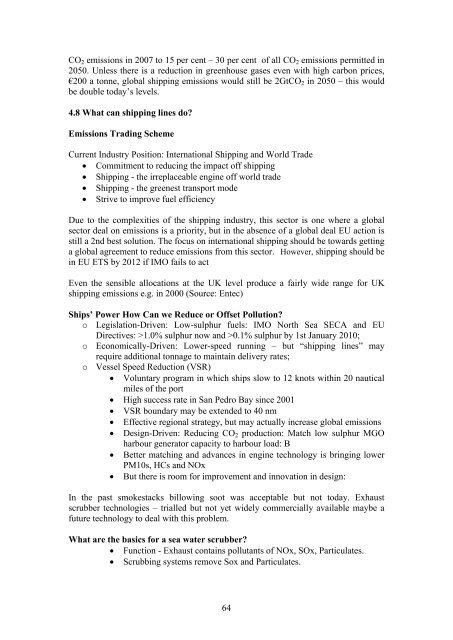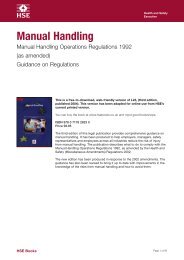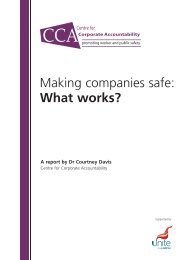Sustainable Transport and the Environment Guide - Unite the Union
Sustainable Transport and the Environment Guide - Unite the Union
Sustainable Transport and the Environment Guide - Unite the Union
You also want an ePaper? Increase the reach of your titles
YUMPU automatically turns print PDFs into web optimized ePapers that Google loves.
CO 2 emissions in 2007 to 15 per cent – 30 per cent of all CO 2 emissions permitted in<br />
2050. Unless <strong>the</strong>re is a reduction in greenhouse gases even with high carbon prices,<br />
€200 a tonne, global shipping emissions would still be 2GtCO 2 in 2050 – this would<br />
be double today’s levels.<br />
4.8 What can shipping lines do?<br />
Emissions Trading Scheme<br />
Current Industry Position: International Shipping <strong>and</strong> World Trade<br />
Commitment to reducing <strong>the</strong> impact off shipping<br />
Shipping - <strong>the</strong> irreplaceable engine off world trade<br />
Shipping - <strong>the</strong> greenest transport mode<br />
Strive to improve fuel efficiency<br />
Due to <strong>the</strong> complexities of <strong>the</strong> shipping industry, this sector is one where a global<br />
sector deal on emissions is a priority, but in <strong>the</strong> absence of a global deal EU action is<br />
still a 2nd best solution. The focus on international shipping should be towards getting<br />
a global agreement to reduce emissions from this sector. However, shipping should be<br />
in EU ETS by 2012 if IMO fails to act<br />
Even <strong>the</strong> sensible allocations at <strong>the</strong> UK level produce a fairly wide range for UK<br />
shipping emissions e.g. in 2000 (Source: Entec)<br />
Ships’ Power How Can we Reduce or Offset Pollution?<br />
o Legislation-Driven: Low-sulphur fuels: IMO North Sea SECA <strong>and</strong> EU<br />
Directives: >1.0% sulphur now <strong>and</strong> >0.1% sulphur by 1st January 2010;<br />
o Economically-Driven: Lower-speed running – but “shipping lines” may<br />
require additional tonnage to maintain delivery rates;<br />
o Vessel Speed Reduction (VSR)<br />
Voluntary program in which ships slow to 12 knots within 20 nautical<br />
miles of <strong>the</strong> port<br />
High success rate in San Pedro Bay since 2001<br />
VSR boundary may be extended to 40 nm<br />
Effective regional strategy, but may actually increase global emissions<br />
Design-Driven: Reducing CO 2 production: Match low sulphur MGO<br />
harbour generator capacity to harbour load: B<br />
Better matching <strong>and</strong> advances in engine technology is bringing lower<br />
PM10s, HCs <strong>and</strong> NOx<br />
But <strong>the</strong>re is room for improvement <strong>and</strong> innovation in design:<br />
In <strong>the</strong> past smokestacks billowing soot was acceptable but not today. Exhaust<br />
scrubber technologies – trialled but not yet widely commercially available maybe a<br />
future technology to deal with this problem.<br />
What are <strong>the</strong> basics for a sea water scrubber?<br />
Function - Exhaust contains pollutants of NOx, SOx, Particulates.<br />
Scrubbing systems remove Sox <strong>and</strong> Particulates.<br />
64
















